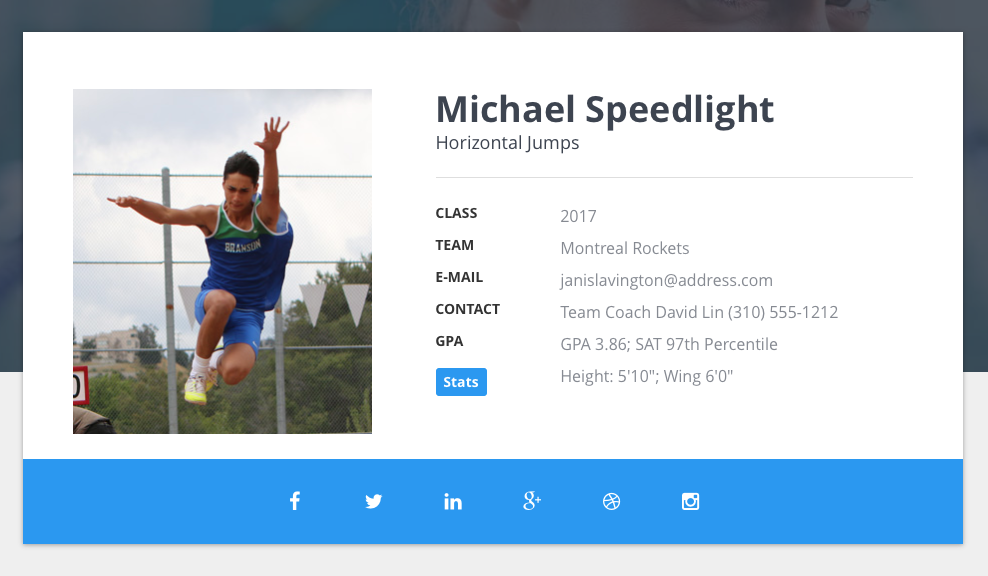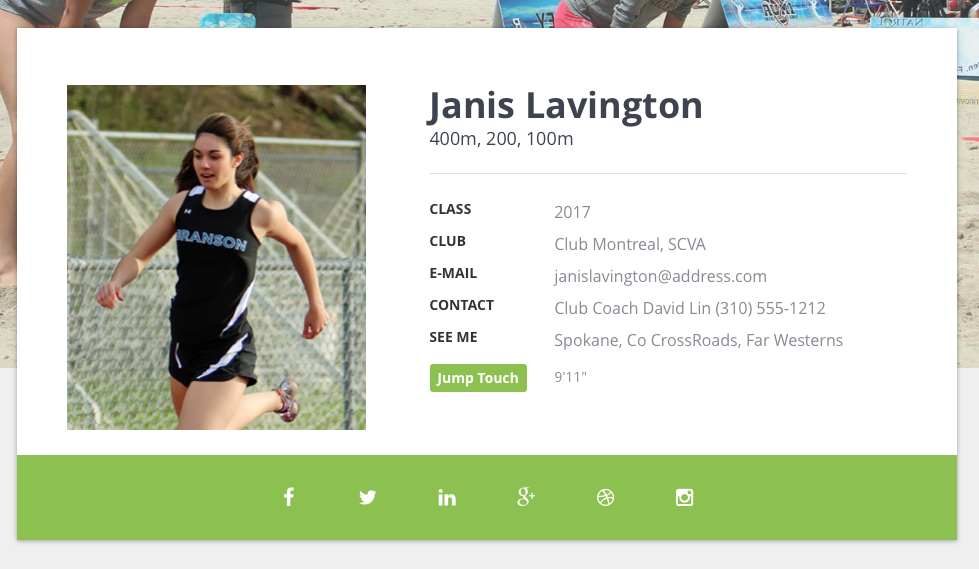With over one million high school track and field athletes and 37,000 NCAA track and field athletes, you might wonder just how fast or far you need to run, jump, or throw to get recruited.
Track and Field Recruiting Standards
Track and field recruiting standards vary across:
- Divisions
- Conferences within each division
- Colleges within each conference
There are general norms explained below for each of these groupings, but the truth is that each individual college sets its own track and field recruiting standards (see links below for some examples). Scholarship standards are even more stringent, and it's important to understand the difference between being good enough to get admissions assistance vs. being good enough to get a track and field scholarship. If you'd like to know more about a specific school's track and field recruiting or scholarship standards, it's easy: just pick up the phone and ask.
In general, the large D1 colleges in the most prominent athletic conferences (Pac 12, Big East, Big Ten, Southeastern, etc.) have the strictest track and field recruiting standards and the most competitive athletes. As you progress from left to right in the charts below, the standards lessen. You can see that the recruiting standards at the Ivy League schools, even though they are D1 (Harvard, Princeton, Yale, Columbia, Dartmouth, uPenn, Cornell and Brown), fall somewhere between the large D1 schools and D2. As a result, the Ivies are a terrific fit for athletes who want a Division 1 track and field experience, but who might not otherwise be able to compete at the top athletic schools. The challenge of getting recruited at an Ivy is that your grades and test scores have to be stellar. Just how stellar? Tier One Athletics has some helpful blog posts about the Ivy League Academic index, and even has its own calculator so you can see where you stack up academically.
Men’s Track and Field Recruiting Standards
Note: These recruiting standards are estimates. Check with your target schools for specifics or explore some of the links below.
| NCAA DI | DI Ivy League | NCAA DII | NCAA DIII | NAIA | |
|---|---|---|---|---|---|
| 100m | 10.5-11.0 | 10.85-10.94 | 10.9-11.2 | 11.0-11.4 | 10.9-11.3 |
| 200m | 21.25-22.7 | 22.0-22.34 | 22.0-24.0 | 22.15-23.5 | 22.5-23.0 |
| 400m | 47.5-51.0 | 49.0-49.54 | 49.0-54.0 | 49.5-53.0 | 49.5-52.0 |
| 800m | 1:52-1:58 | 1:53-1.55 | 1:57-2:05 | 1:57-2:04 | 1:58-2:03 |
| 1,600m | 4:15-4:30 | 4:16 | 4:30-5:00 | 4:30-5:00 | 4:25-4:45 |
| 3,200m | 9:10-9:45 | 9:14-9:20 | 9:30-10:15 | 9:45-10:45 | 9:45-10:30 |
| 110m high hurdles | 13.95-15.9 | 14.20-14.64 | 14.9-15.8 | 15.5-17.0 | 15.5-16.5 |
| 400m hurdles | 51.0-56.0 | 54.0-54.94 | 54.5-57.0 | 56:00-60:00 | 56:00-60:00 |
| High Jump | 7’0″-6’4″ | 6'6″-6'7″ | 6’4″-6’0″ | 6’1″-5’9″ | 6’2″-5’8″ |
| Pole Vault | 16’6″-14’6″ | 14'9″-15'0″ | 14’6″-12’0″ | 15’0″-13’0″ | 14’6″-13’0″ |
| Long Jump | 24’6″-22’0″ | 22'6″-23'0″ | 22’6″-19’0″ | 21’9″-19’6″ | 22’0″-19’6″ |
| Triple Jump | 51’0″-42’0″ | 46'0″-46'6″ | 45’0″-38’0″ | 44’6″-38’2″ | 45’0″-38’0″ |
| Shot Put | 60’10”-45’0″ | 54'0″-57'0″ | 50’0″-35’0″ | 50’0″-40’0″ | 50’0″-40’0″ |
| Discus | 185’0″-155’0″ | 155'0″-170'″ | 150’0″-120’0″ | 150’0″-120’0″ | 140’0″-110’0″ |
| Javelin | 210’0″-170’0″ | 180'0″ | 170’0″-130’0″ | 160’0″-130’0″ | 160’0″-130’0″ |
| Hammer (12lb) | 210’0″-170’0″ | 170'0″-175'0″ | 170’0″-130’0″ | 160’0″-130’0″ | 150’0″-120’0″ |
Women’s Track and Field Recruiting Standards
Note: These are estimates. Check with your target schools for specifics or look at specific recruiting standards in some of the links below.
| NCAA DI | DI Ivy League | NCAA DII | NCAA DIII | NAIA | |
|---|---|---|---|---|---|
| 100m | 11.9-12.34 | 12.00-12.94 | 12.5-13.4 | 12.5-13.5 | 12.87-13.5 |
| 200m | 24-25.54 | 24.50 | 26.2-28.5 | 25.8 | 26.0-28.0 |
| 400m | 54.5-56.94 | 57 | 59.0-68.0 | 59.5-1:04 | 59.5-1:05 |
| 800m | 2:10-2:13 | 2:16 | 2:20-2:42 | 2:20-2:30 | 2:15-2:30 |
| 3,200m | 10:50-11:00 | 11:05 | 11:30-12:15 | 11:50-12:50 | 11:50-12:30 |
| 100m hurdles | 14.5-15.5 | 14.30-14.54 | 15.2-16.5 | 15.5-17.5 | 15.5-17.5 |
| 400m hurdles | 60.0-65.5 | 61.0-62.54 | 63.0-67.0 | 1:07-1:18 | 1:15.5-1:20.5 |
| High Jump | 5’10”-5’2″ | 5'6″-5'8″ | 5’4″-5’0″ | 5’1″-4’9″ | 5’4″-5’0″ |
| Long Jump | 19’6″-17’0″ | 18'3″-19'0″ | 17’0″-15’0″ | 18’0″-16’0″ | 17.0″-15’6″ |
| Shot Put | 45’0″-32’0″ | 42'0″ | 38’0″-32’0″ | 40’0″-32’0″ | 38’0″-34’0″ |
| Discuss | 149’0″-120’0″ | 135'0″ | 120’0″-100’0″ | 120’0″-100’0″ | 120’0″-100’0″ |
| Pole Vault | 12’6″-10’0″ | 11'6″-12'0″ | 11’0″-8’0″ | 11’0″-9’0″ | 10’0″-8’0″ |
| Triple Jump | 40’0″-32’0″ | 38'0″-39'0″ | 35’0″-30’0″ | 36’0″-31’0″ | 35’6″-34’2″ |
| Hammer | 170’0″-140’0″ | 140'″-150'0″ | 140’0″-120’0″ | 136’0″-110’0″ | 120’0″-100’0″ |
| Javelin | 140’0″-120’0″ | 120'0″-130'0″ | 120’0″-100’0″ | 110’0″-90’0″ | 120’0″-100’0″ |
Some colleges publish their track and field recruiting and scholarship standards. Others don't, but you can find standards necessary to compete in their division's championships. Below is a sampling of D1-D3 schools' track and field recruiting standards and performance lists. Where do you fit in?
- USC Men's Track and Field Recruiting Standards
- uPenn Track and Field Recruiting Standards
- Columbia University Track and Field Recruiting Standards
- Dartmouth Track and Field Recruiting Standards
- Villanova Walk-On Standards
- University of North Carolina Track and Field Scholarship and Walk On Standards
- University of North Florida Track and Field Scholarship and Walk On Standards
- Wake Forest Track and Field Recruiting Standards
- MIT Track and Field Recruiting Standards
- 2016 NCAA Division II Outdoor Track and Field Qualifying Standards
- 2016 NCAA Division II Indoor Track and Field Qualifying Standards
- 2009-2016 NCAA Division I, II, and III Indoor and Outdoor Qualifying Standards
- 2013 UAA Outdoor Performance List (The University Athletic Association is made up of NCAA Division 3 schools: Brandeis, Carnegie Mellon, Case Western, Emory NYU, University of Chicago, Rochester, and Washington University St. Louis)
- 2015 NESCAC Championship Qualifying Standards
Athletics Recruiting Websites Can Help with Your Recruiting Process:
 |
 |
 |